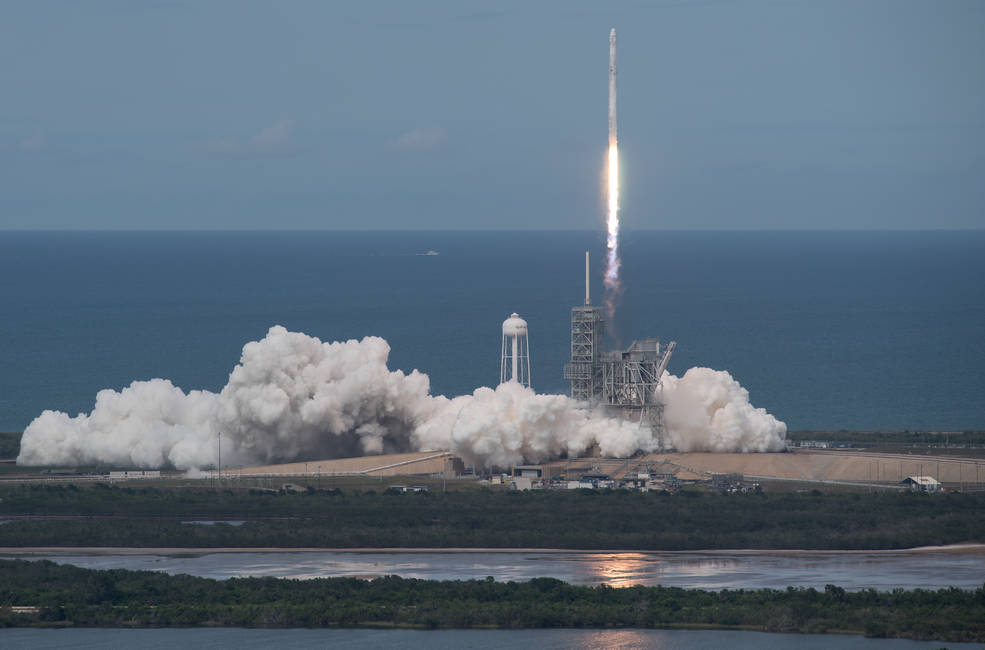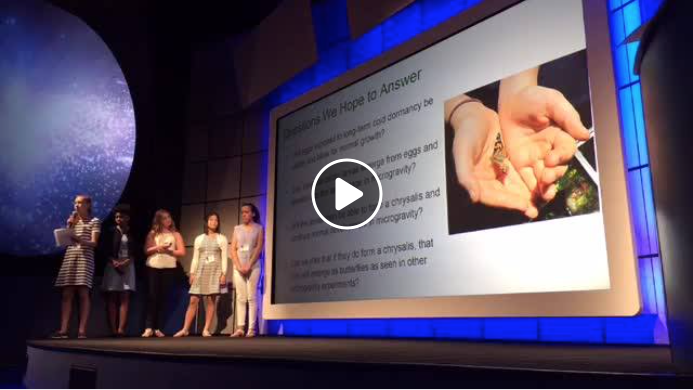To readers – if you would like to wish the Mission 12 to ISS student researchers, their teachers, and their communities good luck on the launch of their experiments on SpaceX CRS-15 from Kennedy Space Center, Florida, you are invited to leave a comment below:)

The SpaceX Falcon 9 rocket, with the Dragon spacecraft onboard – SpaceX CRS-11 – launches from pad 39A at NASA’s Kennedy Space Center in Cape Canaveral, Florida, Saturday, June 3, 2017. Dragon was carrying almost 6,000 pounds of science research, crew supplies and hardware – including 11 student experiments comprising the SSEP Mission 10 Casper payload – to the International Space Station. This was the 100th launch, and sixth SpaceX launch, from this pad. Previous launches include 11 Apollo flights, the launch of the unmanned Skylab in 1973, 82 shuttle flights and five SpaceX launches. We are now counting down to the launch of SSEP Mission 12 Mercury on SpaceX CRS-15 on June 29, 2018. Photo Credit: (NASA/Bill Ingalls) CLICK FOR ZOOM
The SSEP Mission 12 to ISS flight experiments payload Mercury is scheduled to launch Friday, June 29, 2018, at 5:42 am EDT from Space Launch Complex 40, Cape Canaveral Air Force Station, Florida, aboard SpaceX CRS-15.
The launch will be covered live on NASA TV and at SpaceX, and we have provided a video portal below for both if you’d like to watch right here on the SSEP National Program website. Also below is the June 22, 2018, NASA Media Advisory which provides NASA TV live coverage times for launch on June 29, and arrival at Station on Monday, July 2.
A heartfelt congratulations to all student researcher teams for the 34 SSEP Mission 12 flight experiments – we are all very proud of you.
As of this writing, we are at T-minus 10 Hours 42 minutes and counting – see the countdown clock in the right column. Godspeed Dragon.
Dr. Jeff Goldstein
SSEP National Program Director
Center Director, National Center for Earth and Space Science Education
Mission 12 to ISS Historical Data
Number of Participating Communities: 31
Scope: 12,150 grade 5-16 students fully engaged in experiment design
Number of student team proposals received: 2,498
Number of experiments selected for flight: 34; 3 communities flying 2 experiments
Announcement of Opportunity: March 5, 2017
Experiment design competition and proposal writing: September 5 – November 3, 2017 (9 Weeks)
Flight experiment selection: December 14, 2017
MEDIA PACKAGE for Mission 12: Downloadable Documents (PDFs)
SSEP National Program Overview for Congressional Briefings on Capitol Hill
Mission 12 Flight Experiments Summary Table
Mission 12 Flight Experiments: Research Teams and Experiment Descriptions – an experiment-by-experiment summary including community, school, grade level, research team (PIs, Co-Is and Collaborators), and experiment abstract
Historical Multimedia – Mission 10 to ISS Student Researchers Presenting at the Kennedy Space Center Visitor Complex on Launch Day, June 3, 2017
WATCH SPACEX LAUNCH LIVE ON THIS NASA TV PORTAL
http://www.nasa.gov/multimedia/nasatv/#.Ux37dCjn1sQ
WATCH SPACEX LAUNCH LIVE ON THIS SPACEX PORTAL
June 22, 2018
MEDIA ADVISORY M18-098
NASA Television to Air Launch of Next Space Station Resupply Mission
NASA commercial cargo provider SpaceX is targeting no earlier than 5:42 a.m. EDT Friday, June 29, for the launch of its 15th resupply mission to the International Space Station. Live coverage will begin on NASA Television and the agency’s website Thursday, June 28, with prelaunch events.
Packed with more than 5,900 pounds of research, crew supplies and hardware, the SpaceX Dragon spacecraft will launch on a Falcon 9 rocket from Space Launch Complex 40 at Cape Canaveral Air Force Station in Florida.
About 10 minutes after launch, Dragon will reach its preliminary orbit. It then will deploy its solar arrays and begin a carefully choreographed series of thruster firings to reach the space station.
It will reach the space station Monday, July 2. NASA astronaut Ricky Arnold, backed up by fellow NASA astronaut Drew Feustel, will supervise the operation of the Canadarm2 robotic arm for Dragon’s capture while NASA astronaut Serena Auñón-Chancellor monitors the spacecraft’s systems. After Dragon capture, ground commands will be sent from mission control in Houston for the station’s arm to rotate and install it on the bottom of the station’s Harmony module.
Full mission NASA TV coverage is as follows:
Thursday, June 28
11 a.m. – What’s on Board science briefing from Kennedy
Christian Karrasch, project lead at the German Aerospace Center (DLR), and Philipp Schulien, project engineer at Airbus, will discuss the Crew Interactive Mobile companion (CIMON) study into crew efficiency and acceptance of artificial intelligence (AI) support for future use on long-duration missions.
Principal investigators Richard Grugel at NASA’s Marshall Space Flight Center and Oliver Steinbock at Florida State University, will discuss Chemical Gardens studying the physics of nanotube growth.
Simon Hook, principal investigator at NASA’s Jet Propulsion Laboratory, and Woody Turner, program scientist in the Earth Science Division at NASA Headquarters, will discuss the ECOsystem Spaceborne Thermal Radiometer Experiment on Space Station (ECOSTRESS) investigation. This study will answer several key science questions related to water stress in plants and how selected regions may respond to future changes in climate.
Paolo Luzzatto-Fegi, principal investigator at the University of California, Santa Barbara, and Richard Dickinson, director of the Division of Chemical, Bioengineering, Environmental, and Transport Systems at the National Science Foundation, will discuss Quantifying Cohesive Sediment Dynamics for Advanced Environmental Modeling (BCAT-CS), which focuses on the study of forces between particles that cluster together by studying sediments of quartz and clay particles.
Ken Podwalski, director of Space Exploration Operations and Infrastructure for the Canadian Space Agency, will discuss the spare Canadarm2 Latching End Effector (LEE) being launched.
12:45 p.m. – Prelaunch news conference from NASA’s Kennedy Space Center in Florida with representatives from NASA’s International Space Station Program, SpaceX and the U.S. Air Force’s 45th Space Wing.
Friday, June 29
5:15 a.m. – Coverage begins for the 5:42 a.m. launch
8 a.m. – Postlaunch news conference at Kennedy with representatives from NASA’s International Space Station Program and SpaceX.
Monday, July 2
5:30 a.m. – Dragon rendezvous, grapple and berthing at the space station. Capture is scheduled for approximately 7 a.m.
9 a.m. – Dragon installation to the Nadir port of the station’s Harmony module
The Student Spaceflight Experiments Program (SSEP) is a program of the National Center for Earth and Space Science Education (NCESSE) in the U.S., and the Arthur C. Clarke Institute for Space Education internationally. It is enabled through a strategic partnership with DreamUp PBC and NanoRacks LLC, which are working with NASA under a Space Act Agreement as part of the utilization of the International Space Station as a National Laboratory. SSEP is the first pre-college STEM education program that is both a U.S. national initiative and implemented as an on-orbit commercial space venture.
The Smithsonian National Air and Space Museum, Center for the Advancement of Science in Space (CASIS), and Subaru of America, Inc., are U.S. National Partners on the Student Spaceflight Experiments Program. Magellan Aerospace is a Canadian National Partner on the Student Spaceflight Experiments Program.


Discovery Charter School, I’m so proud of all three teams who have represented us at the conference. A special thank you to Susan Leftwich who has supported our winning team throughout their process. I’ll be watching from home, and can’t wait to see your experiment go up tomorrow morning! Congratulations scientists, you have done well!
Principal Perry
Congratulations to our Grady B. Rasco Rockets for having your project chosen to go to the ISS!! The Vrazel family is proud of y’all!! Way to represent Lake Jackson, Texas! Have a great time!!
We would like to wish ,Ms Morales and her students from Quail Vallley GT Academy ,
Quail Valley Middle School from Missouri City Texas, the best of luck and to express
how proud we are for such an amazing accomplishment this year , again good luck on the launch, of your experiment wishing for a huge success!!
We are so proud of Sanger Unified School District in Sanger, California for pioneering the first SSEP Program in Fresno County!
Great job Blaine Bailes! And the Brazosport team from Lake Jackson Texas!! We are all so proud of you!!
I am so proud of these young scientists.
so proud of you Moreno Valley Ca . specially TEAM 12 of Valley View HS
great Job Titan Lam .